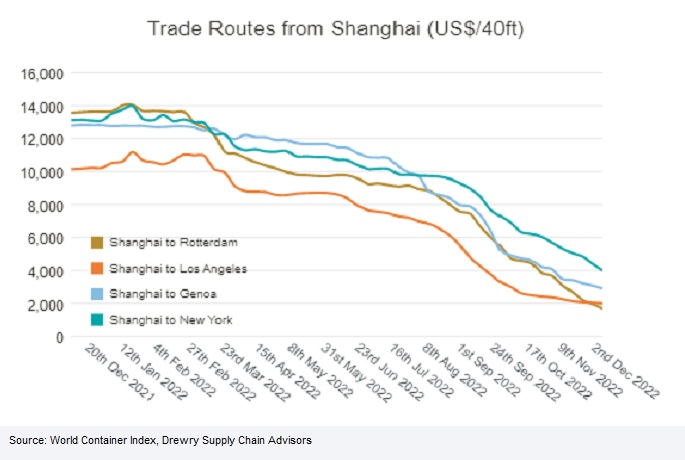
-
Drewry’s composite index fell 6% this week, the 41st consecutive weekly slide, down 77% from levels in the same week last year
-
Freightos says Asia-US West Coast prices fell 26% last week to $1,426/FEU, down 90% from a year ago. Asia-US East Coast prices slid 19% to $3,723/FEU, 78% y-o-y lower
-
Xeneta says the drop in contract rates is not as steep as how spot rates are falling
Container spot and contract rates fell further for trades from Asia to North America, Europe and the Mediterranean this week, with London-based shipping analytics company Drewry’s composite index down 6% this week, the 41st consecutive weekly decrease, and 77% below levels in the same week last year.
Long-term contract rates that shippers sign on major trades are falling as well, but not at the same pace as the spot rates, said Xeneta. The Oslo-based container shipping analytics firm says since January, spot rates had slid 83% while contract rates had lost “only” 24%.
Both rates were on cross-trends around mid-2022 with spot prices declining and long-term rates climbing until they both headed south in September.
The latest Drewry WCI composite index of US$2,139 per 40 feet equivalent units (FEU) or 40-foot container is now 79% below the peak of $10,377 reached in September 2021.
The index is 21% lower than the 10-year average of $2,692, indicating a return to more normal prices, but remains 51% higher than average 2019 (pre-pandemic) rates of $1,420, Drewry Supply Chain advisors said.
The average composite index year to date is $6,638/FEU, up $3,946 from the 10-year average.
Freight rates on Shanghai-Rotterdam dropped 14% or $279 to $1,686/FEU. Spot rates on Shanghai-New York fell 9% or $415 to $3,993/FEU. Similarly, rates on Shanghai-Genoa slipped 6% or $177 to $2,908/FEU. Rates on Rotterdam-Shanghai dipped 3% to $799/FEU.
Likewise, rates on Shanghai-Los Angeles slid 2% to $1,997 and rates on Rotterdam-New York eased 1% to $7,151/FEU. Rates on New York-Rotterdam and Los Angeles-Shanghai hovered around the previous week’s level, Drewry said.
Drewry said it expects smaller week-on-week reductions in rates in the next few weeks.
Freightos said in its weekly update that Asia-US West Coast prices on its Freightos Baltic Index fell 26% last week to $1,426/FEU, down 90% from this week a year ago, while Asia-US East Coast prices (FBX03 Weekly) fell 19% to $3,723/FEU and are 78% lower.
Asia-Northern Europe prices fell 2% to $3,974/FEU and are 73% lower than a year ago.
Freightos said a US Congress vote blocking last week a major rail strike left the big unwind in ocean logistics to continue unimpeded.
Transpacific ocean rates fell sharply again on easing demand and congestion. As empty boxes accumulate at Chinese ports, Asia-US West Coast rates fell more than 25% last week to a level 5% lower than this time in 2019. Asia-US East Coast rates fell 19% but are still 32% higher than three years ago.
“Transatlantic prices dipped slightly last week and have decreased by nearly 25% since August – likely due to carriers shifting now excess capacity to this lane where demand has remained stable and rates are highest at more than $6,000/FEU,” said Judah Levine, Freightos head of research.
Xeneta said across the six main trades out of the Far East, spot rates have fallen 75% since January this year, while not all long-term trades have fallen. On average, the long-term rate has fallen only by 13% across these six main trades out of the Far East.
Xeneta analyst Emily Stausboll said in a blog on Wednesday that as of December 1, the average long-term rate for contracts entering validity in the past three months was at least $1,900/FEU higher than the average spot rate.
In contrast, all average long-term rates on these six trades at the start of the year were below the prevailing spot rate, with long-term rates offering a discount of at least $2,000/FEU.
Stausboll said the largest difference between long and short-term rates can be found on the Far East-US East Coast corridor. At the start of the year, the long-term rates were $4,900/ FEU lower on average than what was available on the spot market. Now, long-term rates are $5,030/FEU or 237% higher than spot rates, she said.
Only the two trades on the Far East-US route out of the six covered here had higher long-term rates at the start of December compared with the start of the year, the analyst said.
She said long-term rates on trades to both coasts have risen about 11% since January 1, 2022, but long-term rates to the US rose slower than other trades and only peaked in Q2 due to the late start to tenders on these trades than elsewhere.
The biggest change in the gap between short and long-term rates on these trades has been on the Far East-North Europe, where long-term rates have gone from $5,640/FEU more expensive to $4,460/FEU cheaper now.
Stausboll said with spot down 83% as against long-term rates’ 24% erosion, the latter have become the more expensive choice.




